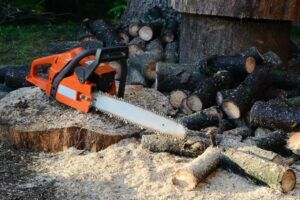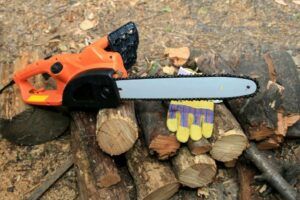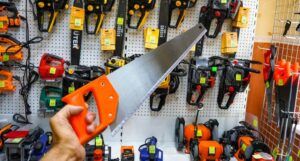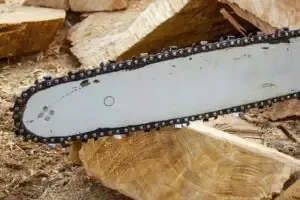
Why Should You Need To Sharpen A Chainsaw?
A well-maintained chainsaw is going to give you good service for many years. Like any other tool, chainsaws also wear out and need to be regularly maintained in order to remain in good working conditions.
Not only is it safer to use, a well sharpened chainsaw is also more efficient as it gets a lot more done work in a shorter time.
A saw chain is made up of cutters, which are designed to cut and depth gauges which control and determine the depth of the cut.
These parts need to be sharp in order to be effective and this is why they should be sharpened whenever they wear out and become dull or blunt.
Using a blunt or poorly sharpened chainsaw can be very frustrating and the chainsaw operator may become fatigued and fail to focus on the task at hand. Dull chainsaws are also more prone to kickback which are the main cause of chainsaw accidents.
When It’s Time To Re-Sharpened Your Chain?

For a chainsaw to work efficiently, the height of the rakers or the depth gauges needs to be slightly less than the height of the cutters.
This difference is very important because if it is too small, the cutters will keep sliding over the wood without actually cutting and if it is too much, the saw will become very jumpy and unstable. This is dangerous and poses a risk to the chainsaw operator.
So how do you know if your chainsaw needs to be re-sharpened? Below are some signs that will tell you when your saw chain has become dull and is due for re-sharpening.
Fine Saw Dust
When cutting through wood, sharp chainsaws produce wood chips. If your chainsaw is producing fine sawdust instead, it is most probably dull and needs to be re-sharpened.
Irregular Cuts And Chains That Vibrate And Jump Erratically
When the chainsaw is blunt, it means that the rakers and the cutters are not working well. Your saw will begin jumping erratically because the saw chains slide and bounce over the wood instead of cutting through.
The saw will also start making irregular cuts. If your chainsaw begins behaving this way, you need to stop and re-sharpen it because continued use could cause accidents.
You Are Using A Lot of Energy To Cut
A well-sharpened chainsaw should cut through wood without application of force. If you realize that you are using a lot of energy to cut wood using a chainsaw, your chainsaw is dull. A sharp chainsaw is fast, efficient, safer and a lot easier to use.
How To Sharpen A Chainsaw

If you are not familiar with prolonged chainsaw use, this can be very frustrating. If you want to save time, energy and ultimately your saw, sharpening the chain is a very big part of using it.
We have gotten to the bottom of best practices on how to sharpen a chainsaw and hope it will keep you cutting and trimming faster and easier than ever before.
Having The Right Tools
Whether you are cutting firewood or just trimming branches in the yard, make sure you have access to these important tools for your chainsaw:
- Chainsaw file
- Saw wrench
- Sturdy work area
These provisions are relatively cheap, though they are just as important as the saw itself and cannot be overlooked.
You can opt for electrical saw sharpeners or special products that make sharpening your saw less of an inconvenience, but for the basic task of sharpening a saw, you will usually need these three standard ingredients as minimum requirements.
The File
A chainsaw file is a round file that fits in the teeth of the saw chain. There are a variety of sizes of files available. Make sure you have the correct gauge file for your chain.
If you are not sure which one to buy or use, you can check the model number of your saw on the manufacturer’s documentation or website or the reference book where you buy your file.
While this seems complicated, it is probably the most difficult part of sharpening your saw. Please make sure you confirm that you are using the right size file for your chain otherwise all your work will have been for nothing.
Pro Tip: Files should sit in the chain snugly, but a quarter of its diameter should rise above the chain.
Saw Wrench
The chainsaw wrench is a combination of two size wrenches and a flat head screwdriver. If you have one of these wrenches that fits your saw it can save time when sharpening.
Of course, you can opt for just a good fitting wrench or socket and a separate screwdriver if you are missing one.
Pro Tip: Some chainsaws now feature bar adjustment systems that make the saw wrench obsolete. The majority of chainsaws still require some tools for bar adjustment.
Sturdy Work Area
You will want to use a sturdy table, a tailgate or some other solid dry surface to sharpen your saw. Ideally, it will be at waist height or at another comfortable level for you to work to save your back and legs from getting sore

Steps To Getting A Sharp Saw Chain
1. Tighten The Chain
As you saw with the chainsaw the chain will likely loosen up. Simply use the saw wrench to adjust the tightness of the chain.
The first adjusts the chain using the wrench to loosen the chainsaw bar. The bar is what they call the blade shaped part of the saw that the chain runs on.
Usually, there are two nuts holding the bar to the rest of the saw. They are usually easily accessible from the outside.
Once loose, there is a screw alongside the bar that will adjust the tension on the chain. Tighten the screw to take the slack out of the chain to allow for a more stable saw and easier sharpening.
2. Find A Starting Point On The Chain
The correct starting point for sharpening on a saw chain is where there are two cutting corners facing the same direction. To identify what part of the chain is a cutting corner.
Find the spot on the chain you are working on that has two cutting corners in a row that are facing the same direction.

Make sure you can safely spin the chain on the bar by hand and look at the links to find the correct starting position.
Pro Tip: While this is not technically necessary for sharpening a chain, starting and stopping on the same link is important for ensuring you get a consistent cutting edge on the entire chain. You can also mark the starting tooth with a felt tip marker as a reference.
3. File The Cutting Corners
When filing the cutting corners, the file will fit in the chain snugly when you find the correct position for the file. You will simply be filing a sharp edge onto the already fairly sharp part of the chain.
For each link, make sure you always:
- Keep the file level when running across the chain. Don’t angle it up or down.
- Use the same number of strokes with the file for each link. It usually takes eight to 20 strokes for each link.
- Keep the file pointed forward at about a 30 degree angle for each cutting corner.
- Twist the file a half turn on each stroke so that you are grinding out the link as well as filing it.
Pro Tip: Every cutting corner faces in the opposite direction of the last one. You will have to either sharpen every other link and then switch directions, or switch directions for every link.
That’s it?
If you want to do more cutting and less sharpening you may want to check out these special products for easier sharpening:
- Depth gauge tool – this tool helps keep the chain cutting at a consistent depth so cutting corners don’t wear unevenly. You simply check the depth with the tool and file the teeth with a special flat file.
- File guide – These file attachments are relatively cheap and offer a visual guide to keep you filing at a perfect 30 degree angle.
- Sharpening vise – holds the saw by the bar so the saw is steady while you work on the chain. This can be a great alternative to leaning over the saw and trying to hold it steady while you work.
- Electric sharpeners – no more manual filing with these special grinders. You can plug them into the wall or hook them up to your car battery to take all the work out of chainsaw sharpening.
That’s it. We must say, however, that knowing how to sharpen a chainsaw makes all the difference when cutting. You will surely notice a huge difference if you follow these steps.
What’s The Best Method To Sharpen A Chainsaw?

A dull chainsaw is not only inefficient and time-consuming but also very dangerous as it increases the risk of kickback. While some chainsaws come with a self-sharpening system.
However, most do not come with this feature and need to be sharpened from time to time when they become blunt to keep them working in the best conditions.
When your chainsaw’s saw chain becomes blunt, you can either take it to be sharpened at your favorite chainsaw service center for a fee or sharpen it on your own.
Although many people view sharpening a chainsaw as a very complicated exercise, it is actually an easy task that you can complete in an afternoon. Learning to sharpen your own chainsaw not only saves you the frequent trips to a chainsaw to the chainsaw service center but also saves your money.
There are several methods used to sharpen saw chains. While some chainsaw users prefer sharpening their blunt chains by hand using a hand file, others prefer using machines.
Others use both the machines and the hand file to complete the task. Below are some of the several methods commonly used by chainsaw users to sharpen their blunt saw chains.
1. Taking It To A Chainsaw Service Center
Saw chains become dull pretty quickly and need to be re-sharpened frequently in order to keep them sharp so that they can keep working efficiently.
The best thing about taking your chainsaw to be sharpened by a professional chainsaw service dealer is that the saw chain becomes sharp as new. However, this also depends on the operators experience and ability in using the machine.
- Advantages
A professional will most certainly sharpen even the dullest chains to be as sharp as new. Better consistency and a decreased chance of improper sharpening which may lead to uneven cutter length. A professional chainsaw sharpener will be able to sharpen a chain according to its manufacturer specifications.
- Disadvantages
If the operator is not conversant with the machine, you may find that a lot of metal is removed from the saw chain during the sharpening process. This wears out the chain all too soon.
It is also quite expensive especially as saw chains become dull very quickly and also inconvenient as you will have to make a trip to the chainsaw service store. You may also have to wait a few days to get your saw chain.
This method is only suitable for homeowners and occasional chainsaw users who may only need this service a few times each year and may not have to make frequent trips to the chainsaw sharpening store.
2. Using A Hand-Held File
This method refers to manually sharpening a saw chain using a hand-held file to sharpen the cutters and the depth gauges of the chain. The guide bar is held in place by a vise-grip as the chain’s teeth are sharpened each at a time.
This ensures that the angle kept is consistent at all times.
- Advantages
This method is inexpensive in that you do not have to spend any money apart from purchasing the file. It is also relatively fast as it can be done in less than an hour and does not limit you in that you can sharpen your chainsaw anywhere you choose to.
The best thing about this method that it is friendly to the chain as it removes the least amount of metal from it during the sharpening which means that your chainsaw will last longer.
- Disadvantages
It requires a skill. Sometimes maintaining accurate angles is quite difficult and may result in uneven sharpening which is dangerous as it may increase the chance of accidents. Best for chainsaw users who have experience using this sharpening method.
3. Using A Dremel tool
When using a Dremel tool to sharpen your saw chain, it is essential to understand the sizes of the stones and what size is suitable for your chain. The sizing is crucial in sharpening a saw chain correctly and successfully.
- Advantages
A Dremel tool works faster than using a hand-held file especially with very blunt tools. You can sharpen your saw chain and use it in under five minutes. With cordless Dremel attachments, you also don’t have to remove the chain from the chainsaw in order to sharpen it.
- Disadvantages
Dremel tools and stones are quite expensive and are often not durable. There is a risk of applying too much heat to a tooth and damaging it. Maintaining angle consistency takes a lot of practice and is bound to be difficult for a beginner or new chainsaw user.
4. Using A Chainsaw Sharpener
There are various types of automated chainsaw sharpeners that are available in the market. They include cordless and corded electric chainsaw sharpeners.
These tools are very handy especially for professional chainsaw users and occasional users who use their chainsaws for heavy tasks and thus go through a lot of saw chains throughout the year.
- Advantages
A chainsaw sharpener is easy to use, fast and enables you to consistently maintain accurate angles when sharpening your saw chains.
- Disadvantages
These machines often remove too much metal from the chains teeth and may reduce the life of your saw chain. Like Dremel tools, it is easy to use too much heat and damage the teeth of the saw chain.
What method is best will obviously depend on the preferences of each specific chainsaw user. Even though using an automated sharpener is fast and easy to use, some chainsaw users still prefer using a hand-held file to sharpen their chainsaws saw chains.
Tips Safety Sharpen A Chainsaw
Many chainsaw owners sometimes fail to sharpen their chainsaws in the correct manner when they become blunt. A chainsaw that is not sharpened properly makes it very difficult to line up cuts accurately which can put the operator in a highly dangerous or even tragic situation.
While this task can seem very intimidating, it is actually very simple and can be completed in less than 20 minutes once you understand your chainsaw and how to sharpen it correctly.
Below are some of the safety measures and guidelines that can be used by beginners or new chainsaw owners when they want to sharpen their chainsaws.
Exercise Due Care
Many chainsaw accidents occur because of human error. It is important to ensure that the chainsaw is mounted on a stable level surface during the sharpening otherwise; the chainsaw may slip and injure you.
Any right thinking person will also not leave the chainsaw in a place where it is accessible to children knowing how dangerous the machine can be. One must always ensure that when sharpening the chainsaw, due care is observed.
Wear Protective Gear
During the sharpening, a chainsaw can still cause injury. It is important to wear eye protectors, chaps, gloves and other recommended protective gear that will protect you from cuts and other risks. It is always better to be safe than sorry.
Read The Chainsaw Manual
Every chainsaw model comes with a manual that equips the user with knowledge about the chainsaw and how it should be maintained.
While it will not make you a pro in maintaining and operating a chainsaw, it will equip you with some basic knowledge regarding your chainsaw.
Some people buy new chains or take their chainsaws to be sharpened at a fee whenever they become blunt. Knowing how to re-sharpen your chainsaw will save you time and money.
Clean The Chainsaw And Check For Signs Of Damage
Use resin solvent to thoroughly clean the chainsaw of all grease, sawdust and particles. Also, check whether the cutters or depth gauge or any other part of the saw chain has been damaged.
In case of damage, replace all the worn out parts before re-sharpening. If the wear out is too advanced and the wear marks have been reached, it is usually advisable to replace the saw chain.
Tension The Chain For Sharpening
When sharpening a chainsaw, it is important to tension the chain tighter than usual because as this will prevent the cutters from slanting.
This makes it easier to maintain correct positions or angles. The chain tension should be restored to normal when the saw chain has been re-sharpened.
Use Appropriate-sized Files
It is important to ensure that the files used for sharpening are appropriate for the particular chainsaw. If the files are too small or too large, they are likely to incorrectly sharpen the chain and even possibly weaken and ruin the structure that holds the chainsaw together.
Proper Positioning Of The File Guide
First place the file guide above the cutter. Then lay it on the guide and ensure that it is in line with the witness marks. Grasp the file with both hands and file from the inside out using full strokes, then apply a little pressure and let up on the return stroke.
Sharpen all the cutter teeth working from the inside of the bar using a proper-sized file and gauge then tune each depth gauge to the corresponding cutter tooth also using the proper depth gauge guide and a flat file.
Ensure that 20 percent of your file diameter is above the top plate at all times in order to maintain proper angles.
Conclusion
Keeping your saw chains sharp is very important because it not only enhances safety but also ensures that the chain cuts faster and more efficiently.
Although you can always take your chain to be sharpened at a chainsaw service center or buy a new one, learning to sharpen your own chainsaw is both convenient and economical because it saves you the frequent trips to the service center and you will also get to save some cash each year.
When you decide to sharpen your chainsaw on your own, you will need to invest in a sharpening tool or file kit that you will use for sharpening your chains when they become blunt. There are a lot of options out there that you can choose from.
The best chainsaw sharpener for you will depend on your needs and your preferences. It is advisable to do a lot of research and to know your chain pitch so that you can find one that is suitable for you.
However, online reviews will make it easier for you because you will be hearing the opinions of actual people who have used the products. This will help you narrow down your search and possibly help you settle on one good chain sharpener. Ultimately, the best chainsaw sharpener is one that best meets your needs and expectations.



![9 Best Pole Saws of 2023 [Ultimate Guide] 9 Best Pole Saws of 2023 [Ultimate Guide]](https://handykeen.b-cdn.net/wp-content/uploads/2021/03/best-pole-saw-300x200.jpg)



